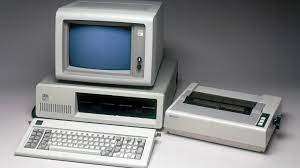On August 12, 1981, International Business Machines Corporation (IBM) made a groundbreaking move that would forever change the landscape of computing. On this day, IBM released its first personal computer (PC), the IBM 5150. The IBM 5150 was a revolutionary product that brought computing power and capabilities directly into the hands of individuals. Prior to its release, computers were primarily large and expensive machines that were used by corporations, universities, and government institutions. The introduction of the IBM PC marked the beginning of a new era, where computing became more accessible and user-friendly for the average person. The IBM 5150 was powered by an Intel 8088 microprocessor and ran on the Microsoft Disk Operating System (MS-DOS). It came equipped with 16 kilobytes of memory, expandable to 256 kilobytes, and had a 5.25-inch floppy disk drive. The system also featured an optional color graphics adapter and a cassette tape drive for storage. One of the key factors that contributed to the success of the IBM PC was its open architecture. IBM decided to use off-the-shelf components and allowed third-party manufacturers to develop and sell compatible hardware and software for the system. This open approach encouraged a thriving software ecosystem, leading to a wide range of applications and games being developed for the IBM PC. The release of the IBM PC had a significant impact on the computing industry. It quickly became the de facto standard for personal computers, setting the stage for the dominance of the IBM-compatible PC architecture that persists to this day. The IBM PC's success also solidified IBM's position as a major player in the computer industry and helped establish its reputation for reliability and quality. The IBM PC's impact extended beyond the business world. It played a crucial role in popularizing computing among everyday users. The affordability and accessibility of the IBM PC made it an attractive option for home use, leading to its widespread adoption in households across the globe. The IBM PC became a powerful tool for productivity, education, and entertainment, forever changing the way people lived and worked. The release of the IBM PC also had a profound effect on the software industry. The availability of a standardized platform allowed software developers to create applications that could run on a wide range of IBM-compatible systems. This led to the rapid growth of software development companies and the creation of new and innovative programs that catered to the needs of various industries and individuals. The IBM PC's impact on the computing industry continues to be felt today. Its legacy can be seen in the dominance of the IBM-compatible PC architecture, which forms the foundation for most desktop and laptop computers. The open architecture and compatibility of the IBM PC also paved the way for other industry standards, such as the USB interface and the expansion of networking capabilities.
12 Aug, 1981 IBM Releases It’s First Personal Computer
